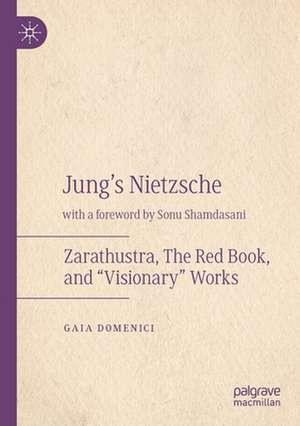Jung's Nietzsche: Zarathustra, The Red Book, and “Visionary” Works
Autor Gaia Domenicien Limba Engleză Paperback – 9 aug 2020
| Toate formatele și edițiile | Preț | Express |
|---|---|---|
| Paperback (1) | 580.68 lei 6-8 săpt. | |
| Springer International Publishing – 9 aug 2020 | 580.68 lei 6-8 săpt. | |
| Hardback (1) | 585.90 lei 6-8 săpt. | |
| Springer International Publishing – 9 aug 2019 | 585.90 lei 6-8 săpt. |
Preț: 580.68 lei
Preț vechi: 683.15 lei
-15% Nou
Puncte Express: 871
Preț estimativ în valută:
111.13€ • 114.65$ • 94.05£
111.13€ • 114.65$ • 94.05£
Carte tipărită la comandă
Livrare economică 05-19 martie
Preluare comenzi: 021 569.72.76
Specificații
ISBN-13: 9783030176723
ISBN-10: 303017672X
Pagini: 250
Ilustrații: XVII, 250 p.
Dimensiuni: 148 x 210 mm
Greutate: 0.33 kg
Ediția:1st ed. 2019
Editura: Springer International Publishing
Colecția Palgrave Macmillan
Locul publicării:Cham, Switzerland
ISBN-10: 303017672X
Pagini: 250
Ilustrații: XVII, 250 p.
Dimensiuni: 148 x 210 mm
Greutate: 0.33 kg
Ediția:1st ed. 2019
Editura: Springer International Publishing
Colecția Palgrave Macmillan
Locul publicării:Cham, Switzerland
Cuprins
Chapter 1: Introduction.- Chapter 2: ʻVisionaryʼ Works And Liber Novus.- Chapter 3: Nietzsche In Liber Novus.- Chapter 4: Liber Novus In Nietzsche: Jungʼs Seminar On Zarathustra.- Chapter 5: Conclusion.
Notă biografică
Gaia Domenici is Honorary Research Fellow at the Institute for Advanced Studies, University College London, UK.
Textul de pe ultima copertă
This book explores C.G. Jung's complex relationship with Friedrich Nietzsche through the lens of the so-called 'visionary' literary tradition. The book connects Jung's experience of the posthumously published Liber Novus (The Red Book) with his own (mis)understanding of Nietzsche's Zarathustra, and formulates the hypothesis of Jung considering Zarathustra as Nietzsche's Liber Novus –– both works being regarded by Jung as 'visionary' experiences. After exploring some 'visionary' authors often compared by Jung to Nietzsche (Goethe, Hölderlin, Spitteler, F. T. Vischer), the book focuses upon Nietzsche and Jung exclusively. It analyses stylistic similarities, as well as explicit references to Nietzsche and Zarathustra in Liber Novus, drawing on Jung's annotations in his own copy of Zarathustra. The book then uses Liber Novus as a prism to contextualize and understand Jung's five-year seminar on Zarathustra: allthe nuances of Jung's interpretation of Zarathustra can be fully explained, only when compared with Liber Novus and its symbology. One of the main topics of the book concerns the figure of 'Christ' and Nietzsche's and Jung's understandings of the 'death of God.'
Caracteristici
Explores how Jung's opinion on Nietzsche changes and develops throughout Jung's life Discusses the figure of 'Christ' and Nietzsche's and Jung's understandings of the 'death of God' Offers a close reading of the Red Book in the light of Jung’s later seminar on Thus Spoke Zarathustra
